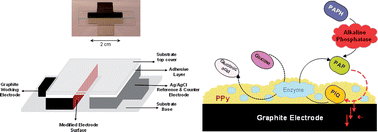Screen-printed microsystems for the ultrasensitive electrochemical detection of alkaline phosphatase†
Abstract
Screen printing technique has been used to manufacture a microsystem where the

- This article is part of the themed collection: Highlighting analytical science in France, Italy and Spain

 Please wait while we load your content...
Please wait while we load your content...